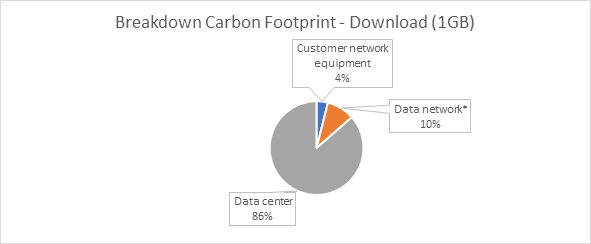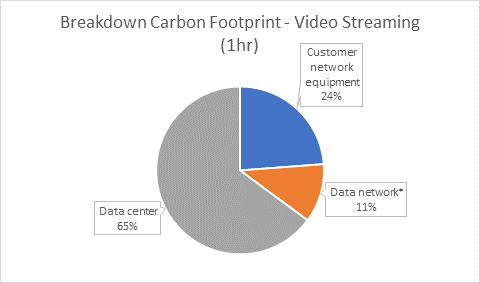How to quantify the environmental impact of internet services
Organizations like the Intergovernmental Panel on Climate Change (IPCC) are drawing attention to our impact on the environment, and it’s not a pretty picture. Our use of the internet even has an impact, and considering its central role in business and commerce, it’s time for private and public organizations to gain a better understanding of that impact.
Many companies do not consider the use of internet services in their corporate greenhouse gas (GHG) balances, although the use of the internet for the operation of a company and for new products is playing an increasingly important role (examples: home office, smart products). So, how can companies account for the environmental impact of internet services to quantify their corporate emissions baseline holistically and inform their decarbonization and net-zero strategies?
Sphera has developed a science-based approach that helps companies assess the complexity of internet and communications technologies (ICT) and quantify their impact. Let’s take a closer look at how this method can be applied.
The Carbon Footprint of a Download
The first internet service in question is the download of a file from a cloud server. For our analysis, we defined very fast digital subscriber line (VDSL) with an average downstream rate of 47.7 Mbps as access technology. For our analysis, we used an internet user based in Europe who is accessing a U.S.-based server.
Considering the data series and assumptions we used, the download of one GB emits 11 grams of CO2-equivalents. The majority of the emissions are from the data center; the data transmission network (excluding the equipment of the user) and the user’s network equipment emit the second and third largest quantities of emissions, respectively.
* Impacts of the manufacturing stage are excluded
What practical lessons can now be drawn from these results? The user can reduce emissions most efficiently by choosing a green data center (e.g., a data center that demonstrates low power utilization effectiveness (PUE) or uses renewable energy) or energy-efficient servers. This might not sound feasible for an individual internet user, but an organization purchasing cloud storage or computing power might have the ability to select its data center operator. Due to the low share of the data transmission network on the overall carbon footprint, the switch to a green data center might lead to a reduction, even if it requires extra data transmission. Nevertheless, this conclusion is highly dependent on the specific situation of the user.
The Carbon Footprint of Video Streaming
The second internet service under observation is video streaming. The following results assume the same access technology as that used for the download (i.e., VDSL). However, it is assumed that the user and server are both located on the same continent (i.e., Europe). This is more representative of the content delivery networks commonly used by Netflix and other streaming platforms to provide their data-intensive services. Additionally, we focus on a streaming quality in full HD (1080p), which determines the data-intensity of the service (GB/hr); in this case, 2.35 GB/hr.
By applying our data series and assumptions, we find that streaming a video in HD emits 36 grams of CO2 equivalents per hour.
The breakdown of the carbon footprint shows that the data center still has the greatest share of the overall result. However, the data transmission network’s share and the user network equipment’s share are significantly higher compared to the carbon footprint results of a download.
* Includes access network, metro network, core network, and undersea cables
There are multiple aspects that explain the results. On the one hand, the services generate relatively high data traffic (used assumption: 2.35 GB/hr). Our modelling approach for data networks and data centers is based on traffic load, while the marginal energy consumption of networks is higher compared to data centers. Consequently, the impacts of networks increase sharply with an increased data volume.
On the other hand, the service has a significantly longer duration compared to the download. This fact is important for the customer network equipment. The electricity consumption of a device like a Wi-Fi router is nearly load-independent. Therefore, the determining variables of the environmental impacts are the average power consumption and the duration of use. Strategies to reduce environmental impacts can use this knowledge to improve the efficiency of such devices and consider whether it is really necessary to run the devices on electricity throughout the day.
Conclusion
The application of Sphera’s approach to modelling the impacts of internet services shows that the results depend primarily on the service and situation (e.g., locations, etc.) in question. In addition, this article has shown that Sphera’s approach can be used to arrive at important practical insights. The analysis of a download showed the relevance of the data center selection, while the calculations for a video stream highlighted the user’s ability to reduce environmental impacts in long-duration and data-intensive internet services.
As internet services become more and more important in our private life and business life, it becomes obvious that their impacts can no longer be ignored. Sphera’s sustainability experts can help organizations quantify the environmental impact of internet service in a holistic, science-based way. Learning more about the impacts of internet activities can improve corporate carbon accounting systems, better inform a robust decarbonization strategy and identify new ways to reduce greenhouse gas emissions to achieve a net-zero emissions target.








